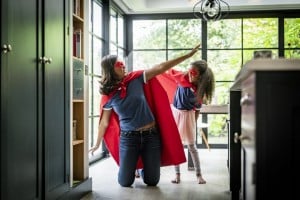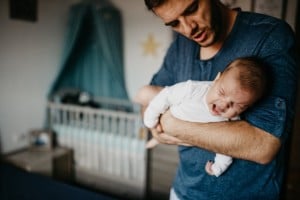It’s hard for kids when they are left out, whether it’s not having anyone to talk to during games or play, being the last one picked for team activities, or not receiving invites to playdates or parties. It can hurt seeing your child being excluded . . . but what if they are the one doing the excluding? Let me start by saying that you are still a good parent, even when this happens. Learning how to include others is something every child has to be taught. I promise you that it gets better with time and the right nurturing.
5 Tips for Teaching Your Child To Be Inclusive
Here are some of the best tips I’ve learned over the years to foster a spirit of inclusion in your child:
1. Use Play To Practice
Play is the work of childhood, and so much can be taught by simply getting down with your child and narrating everyday scenarios. Children naturally learn and express themselves through play, so instead of teaching them a lesson by lecturing, you can model behaviors you want them to replicate. Or get them to practice empathy by pretending to be different characters, which makes kids step into others’ shoes and consider how other people might respond when they play-act.1 Dollhouses or Little People are great ways to encourage this.
During play, maybe your “people” are going to a friend’s house for a playdate, and Sally invites Joe to play with her toy cars. Or perhaps Cindy is sad because Sally and Joe are playing together with a toy that she wants to play with. Talk through how Sally and Joe might invite Cindy to take a turn and join in. This can be done for all situations, not just learning to include others. The opportunities are endless!
2. Lead by Example
From a very young age, your child’s receptive language is consistently higher than their expressive. This means they are taking in a lot more than we think. Be particularly mindful of how you speak about others in front of your child (and how you talk about others in general). This will have a lasting impact on their view of the world, friendships, and how to treat others.2 They look to you for guidance — are you modeling the behavior you hope to see in them?
3. Read Books About Inclusion
I could go on and on about the importance of book-sharing, not only for speech, language, and intelligence but also for teaching valuable life lessons. Find books that talk about including others and books that speak matter-of-factly about those with different abilities, skin colors, religions, upbringings, etc. When a child learns about people who are different from them, it gives them an opportunity to understand various experiences and connect with characters who might initially feel different than them.3 Reading and exposing them to differences helps them to be less afraid of the unknown and get more excited about all the ways we’re different.
4. Use Social Storying Before Playdates
Social storying is something I use daily as a parent. There are different versions, but the simplest one is to discuss what will happen (or is expected to happen) in detail before the event. As you get closer and closer to the event, provide more and more information about it.
There are many right ways to do this, so do what feels the most natural to you and your family. Some families find it helpful to use pictures or books to tell the story. You can easily find photos of friends playing nicely together, save them to an album on your phone, and scroll through them when talking to your child. Here’s an example of when social storying could be helpful:
How To Use a Social Story
Say your child has a playdate scheduled with a friend. Historically, your child bickers and argues over toys. It often ends in both children playing independently and parents tired from refereeing. By using social storying, you can prepare your child to include others ahead of time:4
- A few days before the event, excitedly mention to your child that they have a playdate scheduled with said friend. Talk about how taking turns with their toys will be fun.
- The day before the playdate, happily remind them that they are going to a friend’s house to play tomorrow. Repeat how it will be fun to take turns with their toys. Discuss how it makes our friends sad when we don’t take turns or use unkind words and harmful hands. Remind them of a past incident, and reaffirm that it’s okay to feel upset or sad when a friend plays with a toy we want but that we can take turns to make ourselves and our friends happy.
- On the day of the playdate, repeat the above but add details and scenarios. For instance, if their friend takes their toy, instead of using harmful words or hands, they can use kind words or talk to a parent. If their friend has a toy they want, they could ask to have a turn.
- Right before the playdate, repeat all the above and go into greater detail about situations that might occur. Explain what they can do/what you desire for them to do in those.
You can also tell them a social story afterward about what they did well and discuss how they might be kind again next time. This will build their confidence in being nice to friends. Social storying can begin as early as 18 months of age by simplifying the language.
5. Give Positive Attention and Praise for Inclusion
Positive attention goes a long way when seeking a desired behavior.5 Notice when your child includes others, even if it’s something seemingly small. They will start to notice that they get what they want most — your time and attention — when they include others.
That being said, praise can be a tricky thing. When children receive praise that’s too frequent, not specific enough (i.e., good boy/girl versus telling them exactly what they did well), or a bit too effusive (i.e., a bit over-the-top), it can actually dent their self-esteem. Or they may repeat the behavior because they want/need more praise rather than it being the right thing to do.6 So, try to shift your praise to make it meaningful:6
- Get specific. Tell them exactly what they did well — “I saw that you invited someone sitting alone to come and play. That was really kind.”
- Focus on effort, not outcome. For example, “I can see you tried really hard to share your blocks, even though it was tricky.”
- Ask them to praise themselves. It’s far more impactful for kids to make the connection between their actions and the outcome. For instance, “I noticed you were talking to someone who didn’t have a friend to play with at lunch. Tell me how you think that made them feel. And how do you feel about your choice to do that?”
6. Help Them Feel Empathy for Those Not Included
Sometimes, the hardest lessons are the ones we learn the most from. For example, if you’ve found that your child has been left out, love and nurture their feelings. Acknowledge the incident and help them understand that they can prevent a friend from feeling that way by always including others. You can also reference these hard feelings if your child is unkind to a friend. Gently remind them of how they felt, and ask them openly if that’s how they want their friend to feel. Their answer will most likely be “no,” but remember that it is difficult for little ones to control their impulses. So, while a behavior may appear unkind, it could be a normal developmental milestone.
With these simple yet powerful steps to include others in activities, your child will be that much closer to becoming a more kind human being. In today’s world, that is the best thing we could hope for: to raise our children to be a light to all they encounter.































